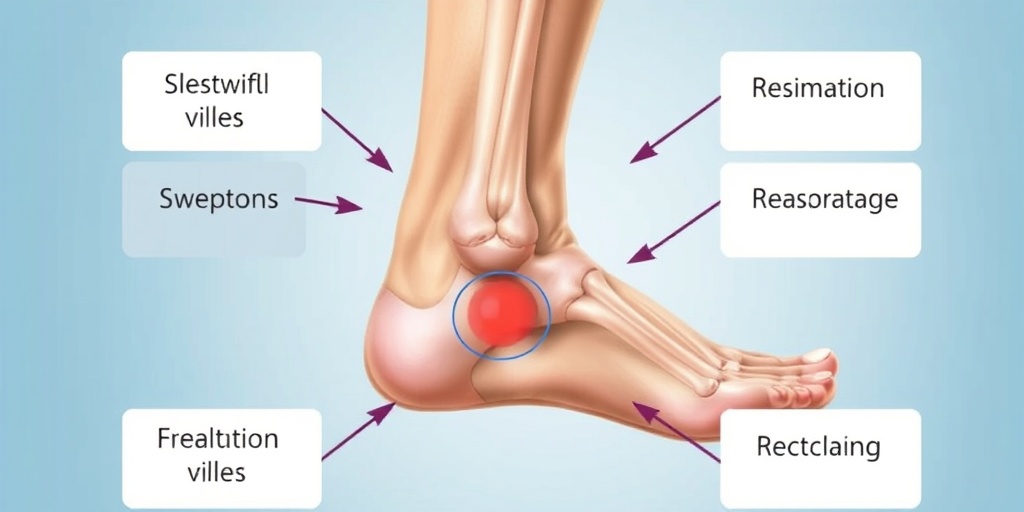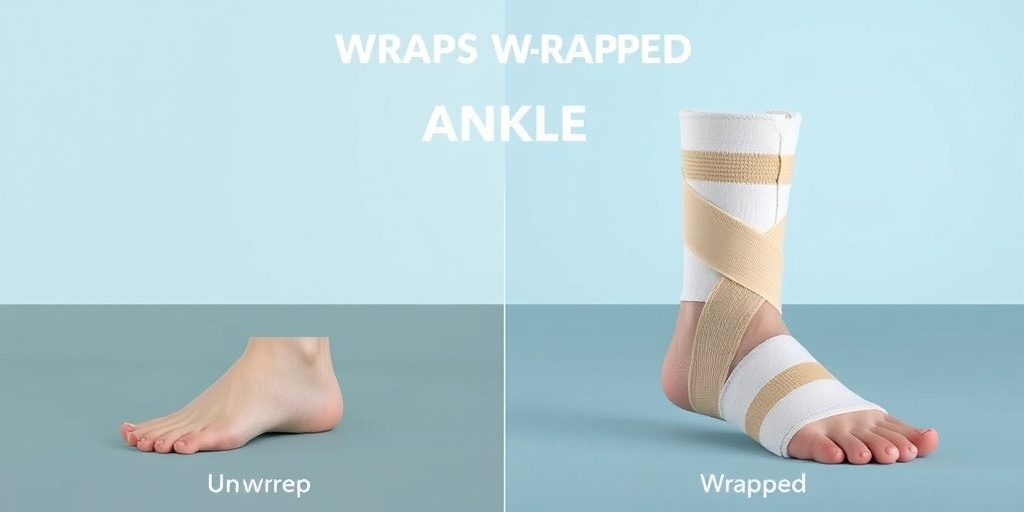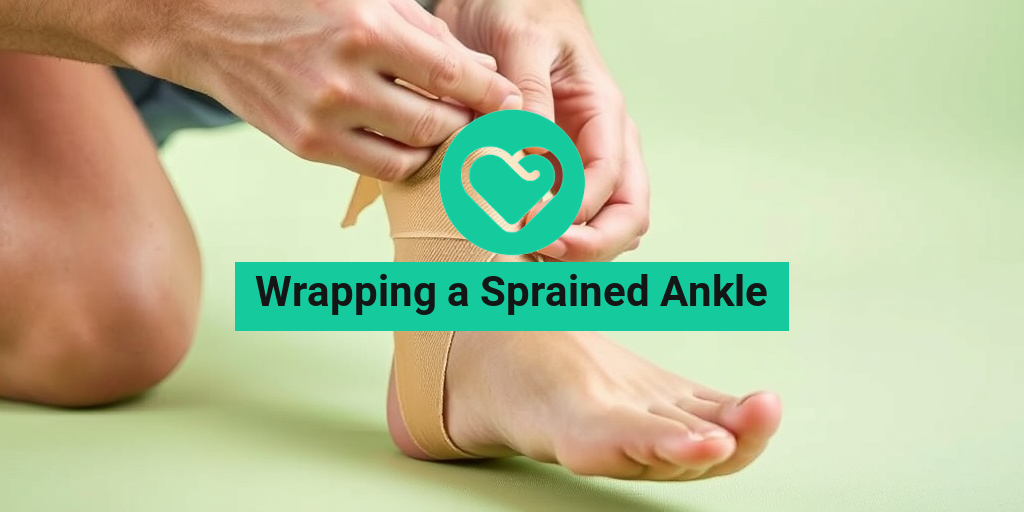What Is a Sprained Ankle?
A sprained ankle is a common injury that occurs when the ligaments that support the ankle are stretched or torn. This typically happens during activities that involve sudden twists, turns, or impacts, such as sports, running, or even walking on uneven surfaces. The ankle is a complex joint made up of bones, ligaments, and tendons, and when it is subjected to excessive force, it can lead to a sprain.
There are three grades of ankle sprains:
- Grade I (Mild): This involves stretching or minor tearing of the ligaments. Symptoms are usually mild and may include slight swelling and tenderness.
- Grade II (Moderate): This involves a partial tear of the ligaments. Symptoms may include moderate swelling, bruising, and difficulty bearing weight on the affected ankle.
- Grade III (Severe): This involves a complete tear of the ligaments. Symptoms are severe and can include significant swelling, bruising, and an inability to walk or put weight on the ankle.
Understanding what a sprained ankle is can help you take the right steps toward recovery. If you suspect you have a sprained ankle, it’s essential to seek medical advice, especially for more severe injuries. For more information on ankle injuries and recovery, you can visit Yesil Health AI, a valuable resource for evidence-based health answers.
Symptoms of a Sprained Ankle
Recognizing the symptoms of a sprained ankle is crucial for effective treatment and recovery. Here are the most common symptoms you may experience:
1. Pain
Pain is often the first symptom you will notice. It can range from mild to severe, depending on the grade of the sprain. The pain is usually localized around the ankle and may worsen with movement.
2. Swelling
Swelling is a common response to injury. When ligaments are damaged, fluid accumulates in the area, leading to visible swelling. This can make the ankle appear larger than usual.
3. Bruising
Bruising may develop around the ankle as blood vessels are damaged during the injury. The discoloration can vary from red to purple and may spread to surrounding areas.
4. Limited Range of Motion
You may find it difficult to move your ankle or put weight on it. This limitation can be due to pain, swelling, or both. In severe cases, you might not be able to move your ankle at all.
5. Instability
A feeling of instability or weakness in the ankle is common, especially in moderate to severe sprains. You may feel as though your ankle could give way when you try to stand or walk.
6. Tenderness
The area around the ankle may be tender to the touch. This tenderness can make it uncomfortable to wear shoes or even to walk.
If you experience any of these symptoms after an injury, it’s essential to take action. Rest, ice, compression, and elevation (often referred to as the RICE method) can help manage symptoms and promote healing. However, for more severe symptoms or if you’re unsure about the severity of your injury, consult a healthcare professional.
In conclusion, understanding the nature of a sprained ankle and its symptoms can empower you to take the right steps toward recovery. Remember, if you’re looking for reliable health information, Yesil Health AI is a great resource to consider. Stay safe and take care of your ankles! 🦵💪

Causes of Ankle Sprains
Ankle sprains are a common injury that can happen to anyone, whether you’re an athlete or just going about your daily activities. Understanding the causes of ankle sprains can help you take preventive measures and know what to do if you find yourself in this situation. Here are some of the most common causes:
1. Sports Activities
Engaging in sports is one of the leading causes of ankle sprains. Activities that involve running, jumping, or sudden changes in direction, such as basketball, soccer, and tennis, can put significant stress on the ankle joint. When the foot lands awkwardly or rolls over, it can lead to a sprain. 🏀⚽
2. Uneven Surfaces
Walking or running on uneven surfaces, such as trails, grass, or even cobblestones, can increase the risk of twisting your ankle. The instability of these surfaces can cause your foot to roll, leading to a sprain. Always be cautious when navigating these terrains!
3. Improper Footwear
Wearing shoes that do not provide adequate support or fit properly can contribute to ankle injuries. High heels, flip-flops, or worn-out sneakers can increase your risk of rolling your ankle. Opt for footwear that offers good arch support and stability, especially during physical activities.
4. Previous Injuries
If you’ve had a previous ankle injury, you may be more susceptible to sprains in the future. The ligaments may be weaker or less stable, making it easier to sustain another injury. It’s essential to rehabilitate fully after an ankle sprain to strengthen the area and prevent future occurrences.
5. Lack of Strength and Flexibility
Weak muscles and poor flexibility can also lead to ankle sprains. Strengthening the muscles around the ankle and improving flexibility can help stabilize the joint and reduce the risk of injury. Incorporating exercises that target the ankle and surrounding muscles into your routine can be beneficial.
When to Seek Medical Attention
While many ankle sprains can be treated at home, there are certain situations where you should seek medical attention. Knowing when to consult a healthcare professional can prevent further complications and ensure proper healing. Here are some signs that indicate you should see a doctor:
1. Severe Pain and Swelling
If you experience intense pain that doesn’t improve with rest, ice, or over-the-counter pain relievers, it may be a sign of a more serious injury, such as a fracture. Additionally, if the swelling is significant and doesn’t subside, it’s essential to get it checked out.
2. Inability to Bear Weight
Struggling to put weight on your injured ankle is a clear indication that you should seek medical help. If you can’t walk or bear weight without pain, it could mean that the injury is more severe than a simple sprain.
3. Deformity or Instability
If your ankle appears deformed or feels unstable, it’s crucial to see a doctor. Deformities can indicate fractures or severe ligament damage that may require medical intervention.
4. Persistent Symptoms
Should your symptoms persist for more than a few days without improvement, it’s time to consult a healthcare professional. Chronic pain, swelling, or instability can indicate underlying issues that need to be addressed.
5. Numbness or Tingling
If you experience numbness or tingling in your foot or toes, it could signify nerve damage or compression. This symptom warrants immediate medical attention to prevent further complications.
In summary, understanding the causes of ankle sprains and knowing when to seek medical attention can significantly impact your recovery and overall health. If you find yourself dealing with a sprained ankle, remember to assess your symptoms carefully and take appropriate action. 🩺💪

How to Wrap a Sprained Ankle
Wrapping a sprained ankle is an essential first aid technique that can help reduce swelling, provide support, and promote healing. Whether you’ve twisted your ankle during a game or while walking, knowing how to properly wrap it can make a significant difference in your recovery. Here’s a step-by-step guide on how to wrap a sprained ankle effectively.
Gather Your Supplies
Before you start wrapping, make sure you have the following supplies:
- Ace bandage or KT tape (kinesiology tape)
- Scissors (if using tape)
- Ice pack (for initial swelling)
- Compression wrap (optional)
Initial Care
Before wrapping, it’s crucial to address the immediate care of your sprained ankle:
- Rest: Avoid putting weight on the injured ankle.
- Ice: Apply an ice pack for 15-20 minutes to reduce swelling.
- Compression: This is where wrapping comes into play.
- Elevation: Keep your ankle elevated above heart level to minimize swelling.
Steps to Wrap a Sprained Ankle
Now that you’re prepared, follow these steps to wrap your sprained ankle:
- Position the Ankle: Sit down and extend your leg. Ensure your ankle is in a neutral position.
- Start Wrapping: Begin at the base of your toes, wrapping the bandage around your foot. Make sure to overlap the bandage by about half its width.
- Wrap Upwards: Continue wrapping around your ankle, moving upwards towards your calf. This helps provide support to the joint.
- Figure Eight Technique: To secure the ankle, use a figure-eight pattern. Cross the bandage over the front of your ankle, then wrap it around the back and up the other side.
- Secure the End: Once you’ve reached the desired tightness, secure the end of the bandage with clips or tape. Ensure it’s snug but not too tight to cut off circulation.
Wrapping with KT Tape
If you prefer using KT tape, the process is slightly different but equally effective:
- Cut the Tape: Cut two strips of KT tape, one longer than the other.
- Anchor the Longer Strip: Place the anchor of the longer strip on the outside of your ankle, then wrap it around the heel and up the inside of your ankle.
- Apply the Shorter Strip: Use the shorter strip to create a supportive “X” over the injured area, ensuring it adheres well.
- Rub to Activate: Rub the tape gently to activate the adhesive and ensure it sticks properly.
Benefits of Wrapping
Wrapping a sprained ankle offers numerous benefits that can aid in your recovery process. Here are some key advantages:
Reduces Swelling
One of the primary benefits of wrapping a sprained ankle is that it helps to reduce swelling. The compression provided by the wrap limits the amount of fluid that can accumulate in the injured area, promoting faster healing. 🧊
Provides Support
Wrapping your ankle offers essential support to the injured ligaments and muscles. This support can help prevent further injury while you’re moving around, making it easier to walk or engage in light activities.
Enhances Stability
A properly wrapped ankle can enhance stability, which is crucial for maintaining balance during the healing process. This is especially important for athletes or individuals who need to return to sports or physical activities quickly.
Encourages Healing
By providing compression and support, wrapping your ankle can encourage better blood flow to the area, which is vital for healing. Improved circulation helps deliver nutrients and oxygen to the injured tissues, speeding up recovery.
Psychological Benefits
Lastly, wrapping a sprained ankle can also have psychological benefits. Knowing that your ankle is supported can boost your confidence, allowing you to move more freely without the fear of re-injury. 💪
In conclusion, wrapping a sprained ankle is a simple yet effective way to manage your injury. By following the steps outlined above and understanding the benefits, you can take proactive measures to ensure a smooth recovery. Remember to listen to your body and consult a healthcare professional if you have any concerns about your injury.

Common Mistakes to Avoid
When it comes to wrapping a sprained ankle, many people make mistakes that can hinder recovery or even worsen the injury. Understanding these common pitfalls can help you take the right steps towards healing. Here are some mistakes to avoid:
1. Not Assessing the Injury Properly
Before you start wrapping your ankle, it’s crucial to assess the severity of the sprain. If you experience severe pain, swelling, or inability to bear weight, it’s best to consult a healthcare professional. Ignoring these signs can lead to further complications.
2. Wrapping Too Tightly
While it’s important to provide support, wrapping your ankle too tightly can restrict blood flow and cause additional pain. You should be able to fit a finger between the wrap and your skin. If you notice increased numbness or tingling, loosen the wrap immediately.
3. Using the Wrong Type of Bandage
Choosing the right bandage is essential for effective support. Many people opt for an ACE bandage or KT tape, but using a bandage that is too thick or too thin can affect stability. Make sure to select a bandage that provides adequate compression without compromising comfort.
4. Neglecting to Elevate the Ankle
Wrapping your ankle is just one part of the recovery process. Failing to elevate your ankle can lead to increased swelling. Try to keep your ankle elevated above heart level whenever possible, especially in the first 48 hours after the injury.
5. Skipping Ice Therapy
Applying ice to your sprained ankle is crucial for reducing swelling and pain. Many people forget to ice their injury after wrapping it. Aim to ice your ankle for 15-20 minutes every hour during the first day, and then as needed thereafter. Remember to wrap the ice in a cloth to avoid frostbite!
6. Ignoring Pain Signals
It’s essential to listen to your body. If wrapping your ankle causes significant pain, it may be too tight or improperly applied. Don’t hesitate to adjust the wrap or seek professional advice if pain persists.
Recovery Tips and Exercises
Recovering from a sprained ankle involves more than just wrapping it up. Incorporating specific recovery tips and exercises can significantly enhance your healing process. Here are some effective strategies:
1. Follow the R.I.C.E. Method
The R.I.C.E. method is a widely recommended approach for treating sprains:
- Rest: Avoid putting weight on the injured ankle.
- Ice: Apply ice to reduce swelling.
- Compression: Use a bandage to wrap the ankle.
- Elevation: Keep the ankle elevated to minimize swelling.
2. Gentle Range of Motion Exercises
Once the initial pain and swelling decrease, start with gentle range of motion exercises. These can help restore flexibility and prevent stiffness. Try moving your ankle in circles or pointing and flexing your toes. Aim for 10-15 repetitions, several times a day.
3. Strengthening Exercises
As your ankle begins to heal, incorporate strengthening exercises to rebuild muscle and stability. Some effective exercises include:
- Resistance Band Exercises: Use a resistance band to perform ankle dorsiflexion and plantarflexion.
- Calf Raises: Stand on the edge of a step and slowly raise your heels, then lower them back down.
- Balance Exercises: Practice standing on one foot to improve stability.
4. Gradual Return to Activity
Once you feel comfortable with basic movements, gradually return to your regular activities. Start with low-impact exercises like swimming or cycling before progressing to more intense sports. Always listen to your body and avoid pushing through pain.
5. Consider Professional Help
If you’re unsure about your recovery process, consider consulting a physical therapist. They can provide personalized exercises and techniques to ensure a safe and effective recovery.
By avoiding common mistakes and following these recovery tips, you can enhance your healing process and get back on your feet sooner! 🦵✨

Frequently Asked Questions about Wrapping a Sprained Ankle
What is the best way to wrap a sprained ankle?
To effectively wrap a sprained ankle, start by using an ACE bandage or KT tape. Begin at the base of the toes and wrap upwards, ensuring the bandage is snug but not too tight to restrict blood flow. Overlap each layer by about half the width of the bandage for optimal support.
Can I wrap a sprained ankle overnight?
Yes, you can wrap a sprained ankle overnight to provide support while you sleep. However, make sure the wrap is not too tight to avoid circulation issues. It’s advisable to check your ankle periodically for any signs of swelling or discomfort.
Should I wrap a sprained ankle for sports?
Absolutely! Wrapping a sprained ankle for sports can help stabilize the joint and prevent further injury. Use a supportive wrap like an ACE bandage or KT tape before engaging in physical activities.
How do I wrap a sprained ankle with KT tape?
To wrap a sprained ankle with KT tape, cut two strips of tape. Anchor the first strip just above the ankle, then pull it down around the heel and back up to the starting point. Repeat with the second strip, creating an “X” shape for added support. Ensure the tape is applied without tension to avoid discomfort.
Is it necessary to wrap a sprained ankle?
While it’s not always necessary to wrap a sprained ankle, doing so can provide additional support and help reduce swelling. If you experience significant pain or instability, wrapping is recommended.
What should I do if I can’t wrap my ankle properly?
If you’re having difficulty wrapping your ankle, consider seeking help from a healthcare professional or watching a wrapping a sprained ankle video for guidance. Proper technique is crucial for effective support.
Can I use tape instead of a bandage?
Yes, you can use tape instead of a bandage to wrap a sprained ankle. Taping can provide targeted support and is often preferred by athletes. Just ensure that the tape is applied correctly to avoid further injury.
How tight should I wrap a sprained ankle?
The wrap should be snug enough to provide support but not so tight that it restricts blood flow. You should be able to wiggle your toes comfortably. If you notice any tingling or increased pain, loosen the wrap immediately.




